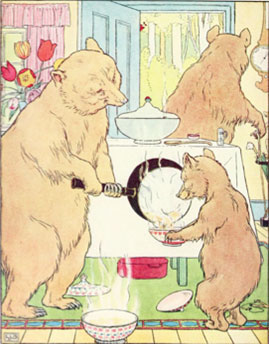Early Stage 1 – STEM Activity 8
Just Right

Description of activity
Students explore how the amount of porridge in a container influences how warm it will remain in a set amount of time.
The suggested time for this activity is approximately 1 hour.
Context
Using the fairytale of Goldilocks and the Three Bears as the context, the students will explore how the quantity of a liquid affects its cooling.
Outcomes
Skills
STe-4WS explores their immediate surroundings by questioning, observing using their senses and communicating to share their observations and ideas
STe-5WT uses a simple design process to produce solutions with identified purposes
MAe-1WM describes mathematical situations using everyday language, actions, materials and informal recordings
Knowledge and understanding
MAe-7NA describes two equal parts as halves
MAe-11MG describes and compares the capacities of containers and the volumes of objects or substances using everyday language
ENe-1A communicates with peers and known adults in informal and guided activities demonstrating emerging skills of group interaction
Resources
- Plastic containers of warm porridge (same size container and quantity of porridge, eg half to a cup per container), two containers per group of students
- Analogue and/or digital clock or timer
Work, health and safety
- Check relevant Work, health and safety guidelines.
- Be aware that students may have food allergies that can result in anaphylaxis or food intolerances
- Provide warm, not hot, porridge (or other liquid). This may be made using a microwave oven
- Be aware of the hazards of using a microwave oven, eg using microwave-suitable containers, no metal and do not super-heat liquids
Evidence of work for assessment purposes
- Sketch design of the test
- Photograph of the test
- Recorded verbal statement or labelled sketch stating the results of the investigation
STEM teaching and learning activities
- Discuss what animals need to survive: food, water, air and shelter. Focus on food and meals of the day.
- Tell the story or watch an animation of Goldilocks and the Three Bears. Recall why Goldilocks ate Baby Bear’s porridge and not Mama Bear’s porridge (too cold) or Papa Bear’s porridge (too hot).
- Pose the question:
- How does the amount of porridge in a container affect how long it stays warm?
- Students discuss the problem and design a way to test it. They will need to devise a way to change the amount of porridge while keeping everything else the same, such as external temperature, size of bowl.
- Students determine a way to compare or measure the amounts of porridge to be tested.
- Students make a sketch diagram showing their test design.
- Once the tests are designed, provide each group with two containers of warm porridge, one full and the other half-full. Other fractions or amounts could be used.
- Students use their hands to feel the temperature of the porridge on the outside of the container.
- Set a timer to 5-minute intervals. Students feel the temperature of the porridge on the outside of the container, every 5 minutes.
- Which container of porridge stayed the warmest? Compare and discuss results.
- On the sketch diagram, indicate which container stayed the warmest after a period of time.
Vocabulary list
Half – two equal parts
Porridge – a warm soft food usually made from oats and eaten for breakfast
Timer – an instrument that measures and indicates time
Key inquiry questions
How much porridge will you put in the containers?
Encourage students to describe the amount of porridge in terms of whether the container is full, half-full or nearly empty.
How will you be able to tell when your container is half-full?
Encourage students to compare the level of porridge in the containers. Point out that: two amounts of porridge are not the same as one container being full and the other containing half the amount. It may be advantageous to use cups rather than bowls if students are having difficulty with this concept.
Additional information
The following statements outline some common preconceived ideas that many students hold, which are scientifically inaccurate and may impede student understanding.
Something divided into two parts is halved
Students often have difficulty in recognising that a half is 2 equal parts, not just 2 bits of the same thing. Halves are made by dividing an object in a particular way. Students may need to divide shapes into two parts and compare them to two equal parts, if they do not understand the concept of one half.
Support materials
- YouTube video: Goldilocks and the Three Bears Rap by Christina Borthwick
- YouTube video: Goldilocks and the three bears - Kids Stories by Learn English Kids British Council
- YouTube video: Give me half by Stuart J. Murphy
Diversity of learners
For additional support- Guide students through the design and production process.
For extension
- Students communicate the procedure for their investigation using labelled sketches, writing or verbal explanations.
- Students explore the effect of different-sized containers (or containers made of different materials) on the cooling process.
Review
In this STEM activity students have designed a method to test a claim and carried it out. These abilities will be developed through all Science Stages. Students’ concept of fractions has been developed and will be expanded in all Stages of Mathematics.
Students will have participated in the practical experiences of comparing sizes and volumes. These are experiences that will assist students to later learn various mathematical, physical and technological concepts.
 NSW Government
NSW Government